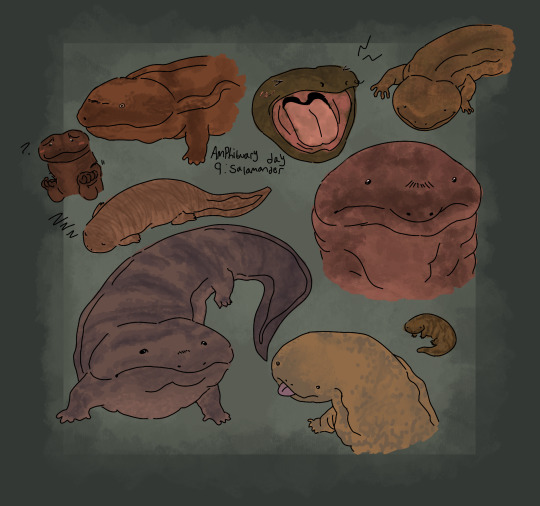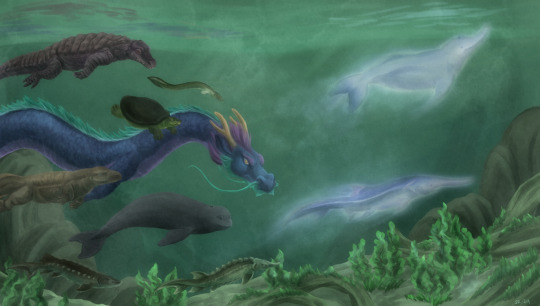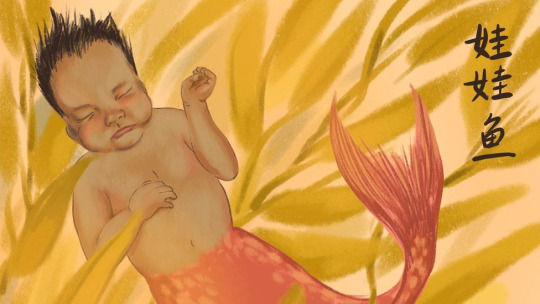#giant chinese salamander
Text

Amphibuary day 9- Salamander! Giant Chinese salamanders are one of my *favorite* amphibians- they’re so cool! Here’s a bunch of em’!
320 notes
·
View notes
Text





But do they love us back?
6 notes
·
View notes
Text

(Ice Coffee Salamander)
I did a redraw and like

WHAT HAPPENED?!????
#art#my art#original character#character design#art redraw#ice coffee#giant chinese salamander#salamander#furry???#amphibian???#idk#bro is vibing ]
10 notes
·
View notes
Text
Wet Beast Wednesday: giant salamanders
Everyone knows salamanders, right? The little lizard frogs that show up around ponds. Well what if I told you that not all salamanders are little. In fact, some species can get quite large, but none get bigger than the aptly-named giant salamanders. I'm not just talking about any big newt, I'm talking about the unique members of the family Cryptobranchidae.

(Image: a Chinese giant salamander. It is a large, lizard-shaped animal with brown skin and black blotches. Its limbs are short and its tail is flattened to look like a long fin. It has wrinkly folds of skin along the side. End ID)
There are three(ish) species of giant salamander in two genera: the Japanese and Chinese giant salamanders of the genus Andrias and the hellbender of genus Cryptobranchus. The name Cryptobranchidae means "hidden gills", which is appropriate as giant salamanders are unique in that they are the only salamanders who reaming fully aquatic as adults without retaining external gills into adulthood. All salamanders are aquatic as juveniles and have external gills and many groups have independently evolved to remain fully aquatic as adults. However, other species, from axolotls to olms, adapted by retaining their external gills as adults, a trait called neoteny. Giant salamanders have had to find another way, especially since a body as large as their needs quite a bit of oxygen. Their solution was to take a common amphibian trait and turn it up to 11. It is common among amphibians to be able to absorb dissolved oxygen in water through their skin. This is usually a supplement to either gills or lungs, but giant salamanders use it as their main means of respiration. The skin is thin and filled with small veins that can perform gas exchange with the water. Giant salamanders evolved very wrinkly skin flaps along ther sides to increase the amount of surface area available for gas exchange, allowing them to sustain themselves. They do require access to running water with a high oxygen content, as still or low-oxygen water doesn't provide enough oxygen to survive. They do have lungs, but use them more for buoyancy control than breathing.

(Image: a man holding/bear higging a giant salamander. The salamander is longer than his torso, not including the tail. end ID)
The Japanese and Chinese giant salamanders are very closely related to each other and rather similar in physiology and behavior. There's also not just one Chinese salamander. Genetic testing has reveals that what was once called Andrias davidianus is actually a species complex. This is when what was thought to be one species turns out to actually be a group of related species. There is some debate over whether the five identified populations of Chinese giant salamander should be classified as subspecies or their own species, though the latter interpretation seems to be the most popular. All the populations are very similar and can interbreed with each other, so I'll discuss them as a group. The largest of the group (and world's largest amphibian) is the South China giant salamander (Andrias sligoi) which can reach 1.8 m (5.9 ft) and 50 kg (110 lbs), but adults average 1.15 m (3.8 ft) and 25-30 kg (55-66 lbs). The Japanese giant salamander (Andrias japonicus) reaches a slightly smaller maximum size of 1.5 m (5 ft) and 25 kg (55 lbs), with most being smaller. The Chinese and Japanese giant salamanders are closely related enough that they can hybridize.

(Image: a Japanese giant salamander resting on mossy rocks underwater. Its body is light brown with darker blotches and the head is covered in nodules. End ID)
Because of how closely related the Japanese and Chinese salamanders are, their biology and behavior are quite similar. They are mostly a dark brown color, but can also be other tones of brown, reddish, or black. The eyes are lidless, small, and poorly-developed, giving the salamanders poor eyesight. Their primary sense comes from the lateral line, a line of hair cells that extends down the body and sense movement of the water. Using the lateral line, the salamanders can sense the movement of prey and threats in the water around them. They utilize suction feeding, slowly approaching prey, then rapidly opening the mouth to generate a vacuum and suck food into the mouth. The prey is then killed or incapacitated with a powerful bite. The esophagus is lined with powerful muscles and uses mucus as lubricant to allow the salamander to swallow large prey. The head and throat have nodules on them, the arrangement and number of which can be used to differentiate Chinese and Japanese salamanders. Both groups of salamander can secrete a strong-smelling, milky white substance to ward off predators. A low metabolism and generally low activity level allows the salamanders to last of up to a few years between meals. The Chinese salamanders can make vocalizations including barks, hisses, and sounds very similar to the crying of a human baby. The hellbender (Cryptobranchus alleganiensis) is smaller than it's Asian relatives, reaching a length of 30-74 cm (12-29 in) and up to 2.2 kg (5 lbs). They are usually brown or reddish-brown, but can also have a gray, yellowish, or black coloration. Hellbender biology and ecology is fairly similar to that of their relatives.

(Image: a hellbender underwater. It looks like the other two species, but is smaller, lighter brown, and has no nodules on the head. End ID)
Chinese and Japanese giant salamanders live in cool, clear streams and rivers in the Yangtze river basin (Chinese) and the islands of Honshou, Kyushu, and Shikoku (Japan). Hellbenders live in similar treams in the eastern United states, with one population (which may be a subspecies) living in the Ozarks region. As predators, their diets include worms, fish, crayfish, freshwater crabs, other amphibians, and small mammals. They are also cannibals and will opportunistically feed on smaller members of their own species. All species are territorial animals that will attempt to drive others out of their territory, though hellbenders are less territorial than the other species. Hellbenders prefer to live in cavities dug out under rocks, which helps them shelter from predators. Due to their low metabolisms, giant salamanders live much longer than most amphibians. Captive individuals have been recorded living for 60 years (Chinese), 52 years (Japanese), and 25 years (hellbender). All species are nocturnal.

(Image: a hellbender emerging from beneath a rock with a crayfish in its mouth. End ID)
Mating occurs seasonally, triggered by warmer water in the summer. During this period, males will search for ideal nesting sites, leaving their territories if necessary. An idea nesting site is sheltered beneath a rock. There are often fewer nesting sites than males, meaning only the largest and strongest males will be able to claim nests. Males then use courtship displays to woo females. Alternatively, male hellbenders will chase passing females into the nests and refuse to let them leave until they mate. Unlike most salamanders, giant salamanders practice external reproduction, where the female lays eggs and then the male fertilizes them. The male then guards the nest until the eggs hatch. During this period, he will keep the nest and eggs clean and use his tail to keep water moving over them. Males will eat eggs that are unfertilized, unhealthy, or show signs of infection. This helps keep the other eggs as healthy as possible. The offspring are born with external gills, which they will lose as they mature. It can take several years for the larvae to reach maturity.

(Image: a group of giant salamander larvae in captivity. They look like smaller versions of the adults, but with feathery gills emerging from each side of the neck. End ID)
Both hellbenders and Japanese giant salamanders are classified as vulnerable by the IUCN, while Chinese giant salamanders are critically endangered. Their primary threats are habitat loss as streams are dammed, dry up, or become polluted. Warming water temperatures also threaten them. Chinese giant salamanders have experienced a major drop in population since the 1950s. In addition to habitat loss, Chinese giant salamanders are also eaten by humans. While hunting wild specimens is now illegal in China, they are heavily impacted by poaching. The fine for poaching giant salamanders is pathetically small compared to the sale price for one of them, further encouraging poachers. Captive breeding and release programs have shown some success, but may have contributed to the spread of disease. In response to the rarity of the salamanders, a new farming industry has sprung up in, raising giant salamanders for food. The captive population of Chinese giant salamanders in farms vastly exceeds the estimated wild population. Chinese giant salamanders have also been introduced to Japan, where they have been hybridizing with the Japanese salamanders, a major hindrance to conservation efforts. Japanese giant salamanders have been legally protected since 1951. The origin of the name hellbender is unknown. Other names for hellbenders include the water dog, Allegheny alligator, grampus, snot otter, and (my personal favorite) lasagna lizard.

(Image: a holding pen in a Chinese giant salamander farm. Over a dozen salamanders are sitting in a shallow water enclosure stocked with bricks and small fish. End ID)
I will leave this post off with a weird fact. In 1726, a Swiss physician named Johann Jakob Schuechzer declared a fossil giant salamander to be the remains of an ancient human who died in the mythical flood of Noah's ark and named it Homo diluvi, meaning "man who witnessed the deluge". In 1812, paleontologist Georges Cuvier examined the fossil and realized (probably very quickly) that it definitely wasn't a human. Once the fossil was identified as a salamander it was given the name Andrias scheuchzeri. As Andrias means "image of man", both the genus and species names acknowledge Schuechzer's weird idea.

Behold: a man (Image: the original Andrias scheuchzeri fossil that Schuechzer thought as a human. It is a front half of the skeleton of what is clearly a lizard-shaped animal and not a human. End ID)
#wet beast wednesday#giant salamander#chinese giant salamander#japanese giant salamander#hellbenders#salamander#amphibian#Johann Jakob Schuechzer bashing#biology#ecology#zoology#animal facts#informative#educational#image described
125 notes
·
View notes
Text

Yangtze spirits
#dragon#baiji#chinese paddlefish#sturgeon#chinese sturgeon#yangtze sturgeon#yangtze finless porpoise#porpoise#yangtze giant softshell turtle#turtle#chinese alligator#japanese eel#chinese giant salamander#wildlife#endangered#extinct#art#artblr
127 notes
·
View notes
Text

The holy mother and child
#I fuckin love viceroy/casey#chinese giant salamander looking ass#rose also has such a shitty lil glare. love it#rose lalonde#casey the salamander#viceroy bubbles von salamancer#homestuck#hs#my art
581 notes
·
View notes
Text

Chinese giant salamander. Scan ended up really blown out for some reason so I had to adjust a lot of stuff in procreate. Also my Posca pen has died or is broken in some way so I had to add a lot of white highlights digitally
#my art#2024#digital art#procreate#traditional art#ohuhu#ohuhu markers#colored pencils#micron#micron pens#alcohol markers#chinese giant salamander#giant salamander#salamander#amphibian#Marker#personal favorite#Art
21 notes
·
View notes
Photo

Amphibiuary Day 16: Giant
A giant salamander, just walking down the road
#amphibiuary2023#salamander#chinese giant salamander#i think#i wanted to play with the perspective to make him seem even taller#and I think it worked :)#my art
223 notes
·
View notes
Text

LOOK AT MY BOY!
#mod art#rotomblr#pkmn irl#Quagsire#ooc: referenced off a pic of a guy holding a Chinese giant salamander
24 notes
·
View notes
Photo



A Big Round of Applause for the Chinese Giant Salamander
The Chinese giant salamander (Andrias davidianus) is one of the largest amphibians in the world, second only to the South China giant salamander (Andrias sligoi) which was only recently distinguished as a separate species. This species typically weights 25–30 kg (55–66 lb) and is 1.15 m (3.8 ft) in length, although It can reach up to 50 kg (110 lb) and 1.8 m (5.9 ft). Its anatomy is well-suited to its aquatic lifestyle; the broad, flat body allows it to creep along riverbeds, and its wide mouth allows it to gulp down any prey it might come accross. Their eyesight is very poor and as a result the eyes themselves are small. A. davidianus‘s skin is typically dark to blend in with its surrounding, and the excess wrinkles provide more surface area through which it can absorb oxygen from the water.
As their name suggests, the Chinese giant salamander is found only in China; specifically fragmented areas from Qinghai to Jiangsu and south to Sichuan, Guangxi and Guangdong. This species is entirely aquatic, and thus is most often found in the basins of the Yangtze, Yellow and Pearl Rivers. A. davidianus lives in caves or freshwater crevices, although they are also seen along lakes or open rocky riverbeds.
Part of the reason this species is so large is because they grow throughout their entire lives. Chinese giant salamanders start out as eggs, which are hatched in groups of 400-500 laid in slow-moving underwater cavities. The eggs are quite large, at a maximum size of 14–16 mm (0.55–0.62 in) after they’re laid and habe absorbed water. They take 50-60 days to hatch, and larvae emerge already resembling their parents, albeit with external gills, and are already 3 cm (1.2 in) long. The young are independent, although they typically stay in the stream they were hatched in until they’re fully grown. The gills are lost at 3 years old, although sexual maturity isn’t reached until 5 to 6 years and a length of 40–50 cm (16–20 in).
Mating occurs between mating occurs between July and September, when the water temperature reaches 20 °C (68 °F). During this time, males push sand and gravel out of their dens to clean them-- a process that can take up to a week-- and ‘shower’ regularly by moving under fast-moving currents. Females are attracted to clean dens, and once she chooses a mate the pair engage in a number of courtship behaviors including knocking bellies, leaning side-to-side, and cohabitating. After the female lays her eggs, she leaves and the male guards the eggs until they hatch. Individuals as old as 60 have been recorded in the wild, although few individuals survive past the larval stage.
Chinese giant salamanders have few predators as adults. The most common are otters, red foxes, weasels and hog badgers, although juveniles can also fall prey to large fish or even adult salamanders. To deter predators, A. davidianus secretes a white acidic, sticky substance from its skin. For the most part this species is the apex predator of its ecosystem, and feeds on insects, smaller amphibians, crustaceans, fish, and the Chinese water shrew (Chimarrogale styani). Individuals detect their prey by a combination of detecting chemicals in the water and a series of nodes along the sides of their bodies that sense vibration. When prey is located, the salamander creates a vaccum with their mouths, sucking in water and their meal.
Conservation status: The Chinese giant salamander is considered Critically Endangered by the IUCN. Primary threats include habitat loss, disease, and over-harvesting for meat. National and international conservation programs and zoos are working to raise awareness, conserve habitat, and raise captive-bred salamanders for re-release in the wild.
Extra fun picture for Chinese New Year:

This picture is from a series of paintings by artist Frankie Huang, who depicts a number of Chinese words literally. In this piece, the Chinese giant salamander is shown as the literal translation of its name in China: Wawayu, or ‘Baby fish’. This name comes from the salamanders’ distinct vocalizations, which can often sound like crying babies.
Photos
Theodore Papenfuss
Egon Heiss
Ben Tapley
Frankie Huang (Instagram)
#chinese giant salamander#Urodela#Cryptobranchidae#giant salamanders#salamanders#amphibians#mountains#caves#rivers#freshwater fauna#subterranean fauna#asia#east asia#animal facts#biology#zoology#happy Chinese New Year!#(ik im two days late but i was moving out of my apartment)#(again)
207 notes
·
View notes
Text
when agitated, clodsire and quagsire secrete a sticky white ooze that can act as an irritant. however, this secretion can also be used for something else: medical glue.
current research suggests that the secretions emitted by these species may well be a more viable alternative to stitches, staples, and other medical adhesives used by doctors and surgeons. a compound derived from this secretion tested on lechonk and rattata overall appears to promote rapid healing and limit scarring and inflammation during the healing process.
#pokémon#pkmn irl#.txt#clodsire#quagsire#[this is legitimate research into the chinese giant salamander complex. not sure where it stands currently.]#[but it’s interesting to read about if you’ve got the time.]
39 notes
·
View notes
Text

Amphibiuary day 16: Swim!
#stop pussy footing around it- are you coming to my Chinese giant salamander’s bat mitzvah or not?!#jk#I love these huge guys! so silly#amphibiuary2024#chinese salamander#chinese giant salamander
107 notes
·
View notes
Text

This was supposed to be yesterday's amphibian but I didn't finish him until just now. The prompt was 'dragon', so I drew a water dragon based on a Chinese dragon and a Chinese giant salamander.
[ID: A digital painting of a Chinese dragon/Chinese giant salamander hybrid swimming underwater. /ID]
#art#digital art#dragon#salamander#water#underwater#amphibuary#amphibuary2023#Chinese giant salamander#Chinese dragon
112 notes
·
View notes
Text

Chinese Giant Salamander, the world's largest amphibian
3 notes
·
View notes
Text

Chinese Giant Salamanders are silly and fun.
@cozy-fish-crow and I were laughing about this last night, so I had to make it a thing xD. based off this YouTube video
#for context: these buds are muddling up the definition of species for biologists and are really good at interbreeding both in farms#and in the wild#watch the vid if you haven't cause it does a better job of explaining than I do :3#chinese giant salamander#animals
17 notes
·
View notes
Text
btw happy fact, pandas aren't endangered anymore.
woo!!!!
now we can put more love and attention ON CHINESE GIANT SALAMANDERS PLEASE I NEED AN UPDATE.
you can't just drop the lore that "oh yeah DNA testing shows theres like 5+ different species lolzor" AND THEN DISAPPEAR FOR LIKE 3 YEARS. (link -> salamanders)
PLEASE I CARE TOO MUCH ABOUT THEM
they are so endangered man, please
9 notes
·
View notes